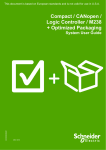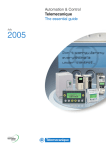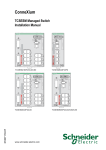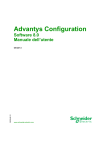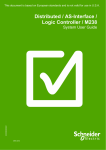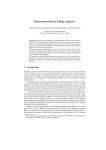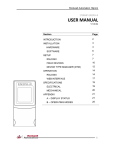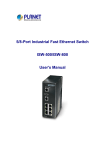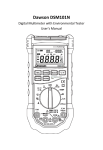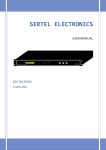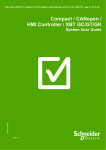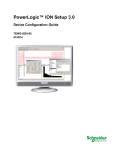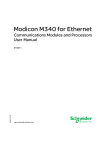Download How can I build my Collaborative Control Platform
Transcript
How can I... build my Collaborative Control Platform System Technical Guide 2 Table of Contents 1 Introduction....................................................................... 4 2 Collaborative control architecture .................................. 7 3 Plant information management ..................................... 11 4 Collaborative control...................................................... 19 5 Motor control................................................................... 27 6 Instrumentation............................................................... 31 7 Power management........................................................ 34 8 Cabinet description ........................................................ 37 Glossary ................................................................................. 54 3 1-Introduction Introduction Definition Collaborative Control Architecture is a solution platform built to facilitate the implementation of collaborative control and information management functions. Objectives In “How Can I…”, the architecture building project, several STGs (System Technical Guide) have been tested and validated on “Collaborative Control Architecture Solution Platform”. This concise and readable document has been created to help the reader acquire a comprehensive understanding of this platform. All sectional architectures and components deployed in this platform are introduced. 4 1-Introduction Document Overview This document starts with an analysis of customer requirements for automation architecture in Chapter 2, Collaborative Control Architecture. Based on this, the 5 sectional architectures provided by Schneider Electric are explained in the following chapters: • Chapter 3, Information Management: Plant operation data acquisition and analysis • Chapter 4, Collaborative Control: PLC (Programmable Logic Controller) and I/O system • Chapter 5, Motor Control: Motor control, protection, monitoring and metering • Chapter 6, Instrumentation: Measurement devices • Chapter 7, Power Management: Power distribution, supply and monitoring Note: All sectional architectures are interconnected. The CCA solution platform is installed in 6 cabinets. Chapter 8, Cabinet Description completes the description of the platform. 5 1-Introduction How to Use This Guide This document is complimentary reading for the “How Can I…” STGs (System Technical Guides) about the CCA solution platform. No technical details about designing applications on this Collaborative Control Architecture are described here. Readers can get these contents from the related STGs available on the Schneider Electric Village portal: http://the-village.schneiderelectric.com/Business_Offer/Solutions_EndUsers/SiteMgr.nsf/. With a full and correct understanding of both the Collaborative Control Architecture and customer constraints, readers can modify this platform to build customized architectures. The product descriptions in this document do not replace other Schneider Electric related User Manuals or technical publications. There is a glossary to help you understand the terms used in this document at the end. Safety Notice The standards and level of safety you apply to your system is determined by its design and the extent to which your system may be a hazard to people and equipment. Building a system based on the architectures introduced in this document does not relieve the user from adhering to, the relevant national and international safety laws and regulations. 6 2-Collaborative Control Architecture Collaborative Control Architecture Collaborative Control Architecture Solution Platform Overview The CCA (Collaborative Control Architecture) Solution Platform is based on a full understanding of customer requirements by Schneider Electric. Both highperformance offers (automation & power distribution) and advanced network and field bus technologies are integrated to fulfill these automation architecture requirements. The key principles deployed for the design of the “Collaborative Control Architecture Power Management Plant information network SCADA servers Historian servers Instrumen- Motor control tation Collaborative control Plant information management Solution Platform” are introduced below. Layered Architecture Layered Architecture is one of the key customer requirements during the system design phase. Depending on the different collaborative control and information management functions, different products should be assigned to different sections to enable flexible interconnection and interoperability within and between sections. 7 2-Collaborative Control Architecture The CCA uses this “Layered Architecture” concept. Schneider Electric provides answers for all 5 functional sections: 1) For the Plant Information Management Section, Schneider Electric provides: a) Ampla as MES (Manufacturing Execution System) software b) Vijeo Citect as SCADA (Supervisory Control and Data Acquisition) software c) Vijeo Historian as the report generation and publication tool d) The FactoryCast family for enhanced traceability using the Web service 2) For the Collaborative Controller Section, depending on the size of control system, Schneider Electric provides the Modicon Quantum, Premium and M340 PLC controllers. All these PLCs (Programmable Logic Controllers) are programmed by the same Unity Pro software. 3) For the Motor Control Section, Schneider Electric provides the ATV (AlTiVar) VSDs (Variable Speed Drives) and TeSys Motor Starters to manage motor and pump control. The PowerSuite software can be used to configure the ATV drives, TeSys U starter and TeSys T controller. 4) For the Instrumentation Section, nearly all the intelligent instrumentations can be integrated into CCA with the Profibus PA field bus. 5) For Power Management Section, Schneider Electric provides APC UPSs. Uninterruptible Power Supplies to momentarily sustain power supply to data servers and PowerLogic meter to monitor the alternating power in automation system. Transparency Transparency is an architecture requirement for communication within or between sections. Based on network or field bus technology, all cabling system (switches, gateway, etc.) become invisible, which makes the communication among devices seems to be point-to point. Then the architecture designer can configure the communication without extra programming. Ethernet is widely used as intranet, industrial control networks and field buses in the CCA. Based on common TCP/IP protocols, managers and plant operators can easily access real-time data from the plant via SCADA or HMIs (Human Machine Interfaces). All the networks, field buses and devices are transparent to them. Except for these, the majority of Schneider Electric Ethernet offers are embedded with the web technology. By viewing web pages stored in the Ethernet devices with 8 2-Collaborative Control Architecture any standard web browser, management and operation staff can immediately get configuration and diagnostic information about these devices. Diversity Diversity sets high requirements for system flexibility. For the same control functions, based on customer constraints, suitable architecture using different products must be provided. Depending on the scalability of the control system, midrange PLCs Modicon M340, Premium, and the high end PLC Modicon Quantum are deployed in the CCA. The Modicon M340 and Premium are more suitable for plant control, while the Modicon Quantum has better performance in hybrid and process controls. Depending on the motor control specifications, different types of motor control architecture are provided in the CCA. TeSys U and TeSys T provide the DOL (Direct On Line) control mode, which provides protection, metering and monitoring of the motors while ATV 31 and 71 are Variable Speed Drives that can perform extra speed controls. Availability Availability is a customer requirement for continuous production. Unexpected production stoppage not only reduces the plant productivity but may also cause the loss of assets and intermediate products. So, redundant architectures are commonly deployed in key process sections to ensure uninterrupted production. Depending on system availability requirements, stand-alone and Hot Standby architectures are included in the CCA Platform. This high availability can be realized at different CCA layers by using Ethernet Dual Rings, the Quantum / Premium HSBY (Hot StandBY) controllers, redundant DIO (Distributed Input and Output) islands and redundant drives & instrumentations. 9 2-Collaborative Control Architecture Safety Safety is the most critical requirement in some process industries, since any malfunction in these industries may result in a catastrophic accident. Therefore, SISs (Safety Instrumented Systems) are required to perform key safety control functions. The IEC 61508 functional safety standard defines 4 System SILs(System Integrated Levels) for safety, SIL1 to SIL4 (the highest). The IEC 61511 standard is a guide on how to design and build a SIS for a process control application. Depending on the SIL requirements safety and non- safety architectures are integrated in CCA platform. Certified by TÜV Rheinland, Safety Quantum can provide SIL2 protection to a process control. The Safety Quantum platform can communicate with the Non-safety PLC platform, but the interoperability between the platforms is strictly limited to avoid interference with the safety part. Compatibility During expansion and retrofit phases, a reliable method must be provided to integrate the newly designed architecture with existing systems. The expansion and retrofit cost and the influence on the existing system must be minimized. The CCA provides compatibility to nearly all devices, instrumentations and architectures available from different providers. Profibus DP/PA (Decentralized Periphery / Process Automation) is included to enable the interconnection between the CCA and the devices in Profibus DP/PA installed base. Furthermore, third party instrumentations (such as Endress + Hauser) and PAMS (a Plant Asset Management System, such as FieldCare) are also integrated into the CCA. With Ethernet and Profibus PA support, these third party offers can help customers greatly reduce their operation and maintenance costs. 10 3-Plant information management Plant information management Introduction In process automation applications, Vast quantities of data about Plant Operation Data, Maintenance Data and Quality Data need to be collected to make synchronized analysis. The goal is to increase productivity and profitability. Plant information management MES Operator workstation Operator workstation Historian Asset management Printer Web client RAS SCADA servers Historian servers Schneider Electric Information Management architectures include MES and SCADA functions. The MES software Ampla, which will be integrated into the CCA platform later, is briefly introduced… Then a detail description about Vijeo Citect, Vijeo Historian, FactoryCast and PAMS are provided. Ampla MES are used to reveal opportunities for improved business performance and increased profit margins. MES solutions enable corporate, IT (Information Technology), plant and production managers to improve OEE (Overall Equipment Effectiveness) and increase production and profitability by transforming and presenting real-time information into a business context throughout the enterprise. Ampla adopts a non-invasive, modular approach. It leverages open technologies to complement existing automation and IT systems. Ampla solutions are deployed in a modular fashion, where each module delivers specific benefits to aid in improving each business need independently. Each module has a targeted purpose with a focus on returning a measurable ROI (Return of Investment) in key areas such as production, quality, traceability and downtime. Data is stored in an open, industry standard database such as MS SQL or Oracle, thus allowing seamless integration with existing business infrastructure and reporting systems, complying with IT requirements and further reducing the cost of ownership. 11 3-Plant information management Ampla can integrate the modules together and, along deploying new modules, provides an exponential increase in value. In the CCA platform several modules are selected to perform the following MES functions: • Ampla Metric: Calculation and generation of KPIs (Key Performance Indicators) • Ampla Production: Analysis of real time data and generation of reports • Ampla Quality: Analysis, reporting and managing of product quality • Ampla Inventory: Management and tracking of inventory and material movement • Ampla Planner: Bridging the gap between ERP (Enterprise Resources Planning) systems and plant floor systems (e.g., SCADA) • Ampla Knowledge: Creation of a knowledge repository to store all operator experience Scada and HMI This part of the installation is dedicated for the control and the supervision of the CCA. Vijeo Citect Vijeo Citect is a SCADA product provided by Schneider Electric. It is a library-integrated and object-oriented development environment. Thanks to this architectural advantage, high flexibility is provided to customers during application development. 12 3-Plant information management Operator workstation Plant information network SCADA servers From the architecture point of view, the intrinsic flexibility of Vijeo Citect is shown in: • High availability Customers can define redundant servers (Alarm, Trend and Report servers) for one application. In the SCADA Server mode, more than one monitor client can be defined to increase the monitoring availability. Vijeo Citect can also connect Dual Ethernet architecture to increase the availability of communication between the SCADA and PLC systems. • High interoperability and interconnection Customers can use OPC to enable data exchange between SCADA and PLCs or among several SCADA systems via Ethernet. Vijeo Citect also performs as the interface between collaborative control and the MES-layer software, e.g., Ampla and Vijeo Historian. In the CCA Platform, there are two enterprise-class rack servers (“machine” is used to differentiate the hardware server and Vijeo Citect functional servers created on these machines). These two machines are dedicated to the creation of Vijeo Citect Alarm Servers, Trend Servers, Report Servers and I/O Servers. On the Plant Information Management intranet, Vijeo Citect Servers, Vijeo Historian Servers, iPC (designed as Vijeo Citect Client) and the PAMS PC are interconnected. These two machines are connected to the Ethernet Dual Ring via ConneXium Management Switches. These switches are also the routers between the Ethernet Dual Rings and the Plant Information Management intranet. 13 3-Plant information management Because Vijeo Citect provides high flexibility to the architecture design, two possible architectures are proposed depending on the system availability requirements: • Single Server In the Singer Server architecture, only one of the two machines is attached to the Ethernet Dual Ring. Only one set of Vijeo Citect Alarm, Trend, Report and I/O servers is defined. It is connected to two ConneXium Managed Switches located on different Ethernet Rings to enable high-available communication with the PLCs. • Redundant Server In the Redundant Server architecture, the maximum availability based on Vijeo Citect is assured. Both machines are connected to an Ethernet Dual Ring via different Ethernet ports. Redundant Vijeo Citect functional servers (Alarm Server, Trend Server, Report Server and I/O Servers) are created on the machines. The communication between Vijeo Citect and Unity Pro can be through ModNet or OFS(OPC Factory Server). ModNet can only be used when all variables from Unity Pro are located variables, OFS does not have this limitation. For more details about how to configure ModNet and OFS communication, please refer to the related STGs. Vijeo Designer Vijeo designer is a design tool for the simplest control application up to high-end HMI installations. It is specifically designed for configuring the Magelis® XBT-GT graphic terminals, Smart iPC and Compact iPC. Magelis HMI In the CCA platform, a Magelis panel is installed. The goal of this panel is to simulate different faults for the application running on this platform. 14 3-Plant information management Vijeo Historian Vijeo Historian is a Report Design, Generation and Publishing tool. It helps optimize data usage by providing a powerful, enterprisewide reporting tool that collects, records and delivers meaningful reporting data from multiple and disparate systems. Using the information provided by Vijeo Historian, more effective decisions can be made to optimize operational performance. Plant information netwo rk Historian servers Comprising Historian and portal functionality, Vijeo Historian empowers IT systems with accurate data storage and long term reports. All these reports can be accessed and visualized through Vijeo Historian Portal, Microsoft Excel and Reporting Service. Vijeo Historian provides tools for reporting customization and connection to SQL Server 2005. More Advanced report designs and user application development can be done in Microsoft Visual Studio 2005. In the CCA Platform, Vijeo Historian works with Vijeo Citect to provide high traceability of operational data. Vijeo Citect is the unique data resource for Vijeo Historian. Although Trend and Report servers can be defined on the SCADA server, the capacity of historical data storage on the server is very limited. As a complement, Vijeo Historian provides magnitude historical data and reporting schemes that fulfill customer requirements for historical data management. One machine acting as the Vijeo Historian Server is connected to the Plant Information Management intranet. It shares the same engineering station with 2 other SCADA servers located on the same intranet. All databases managed by the userdefined SQL Server are stored on this server. Published information is visible to operators (if they have access rights) by using any web browser. 15 3-Plant information management Plant Asset Management System (PAMS) The PAM system is a combination of hardware, software, and services deployed to help the workforce predict and assess the health of plant assets. This is done by monitoring asset conditions periodically or in real time to identify potential problems before they affect the process or lead to a catastrophic failure. With the requirement for open and transparent communication between PAMS and field devices from different manufacturers, new technologies such as FDT/DTM (Field Device Tool / Device Type Manager) have been introduced into PAMS. Plant information network PAMS is a relatively independent component in a CCA platform. Based on specific customer requirements, PAMS can be selected from different suppliers, such as PACTware (PACTware e.V.), FieldCare (Endress + Hauser) and FDT Container (M&M Software). In the CCA platform, Fieldcare is chosen as the PAMS. FieldCare is an Endress+Hauser's FDT based Plant Asset Management Tool that provides a range of functionality from simple device parameterization to engineered Condition Monitoring solutions. It can configure all intelligent field devices in the plant and supports customers in managing them. By using status information, it also provides a simple but effective means of checking their health. For more details about FieldCare please refer to technical documentation from Endress+Hauser. In the CCA platform, a PAMS station (a PC) that has FieldCare installed is connected to Plant Information Management intranet. All instrumentation maintenance jobs are operated from this station. The only instrumentation in the CCA platform is a thermoresistor TR24 PT100 Temperature from Endress + Hauser. The communication between this instrument and FieldCare system is via Profibus (PA / DP) and Ethernet. 16 3-Plant information management Web Services Schneider Electric offers a wide range of TR (Transparent Ready) products: Controllers and PLCs, industrial PCs, HMI devices, Variable Speed Drives, Distributed I/O modules, Gateways, Web servers, Switches, SCADA software, inductive identification systems, etc. These products provide different levels of Web services and communication services over Ethernet TCP/IP, according to user requirements. With these embedded web services, customers can easily access or customize the product information, such as maintenance / real-time data and diagnostic information. In the TR approach, Ethernet modules and Web gateways offer different levels of Web services (Standard, Configurable and Active). To increase the architecture maintenance and diagnostics, many TR offers are integrated into the CCA Platform. The table below lists the offers in the CCA Platform that provide TR Web Services and their related Class. 17 3-Plant information management Description M340 CPU, with Ethernet/ CANopen Ports Premium HSBY CPU Web Service Class B Class C x x x Premium ETY module 10/100 Ethernet, Webserver Quantum HSBY CPU Quantum Safety Stand-alone CPU, SIL2 x x x Quantum NOE module, 10/100 Ethernet Webserver Advantys STB standard NIM, Ethernet Port Magelis XBT GT 7.5” x x Ethernet Card for ATV 71 x Predefined (Class B) or use-defined (Class C) web pages can be visited via the IP addresses of the offers in the table above. All the data can be accessed using any Web browser that supports embedded Java code. The standard functions provided by the Web server are supplied “ready-to-use” and, therefore, do not require any programming of either the PLC or the client PC device supporting a Web browser. For more details about the functions provided by TR offers, please refer to Schneider Electric “Transparent Ready” User Manual. 18 4-Collaborative control Collaborative control Introduction Collaborative Control is the architecture designed to answer customer requirements for process controllers. In this architecture, the key questions to answer are how to choose controllers, how to set up communication among controllers and enable communication between controllers and devices/instrumentations. Collaborative control Engineering CANopen Ethernet Profibus Ethernet In this chapter, CCA platform architectures are described to answer these questions. Ethernet Dual Ring The ConneXium switches are used in the CCA platform to form the Ethernet dual ring. The Ethernet dual ring architecture ensures that whenever one communication path is blocked, an alternative path can be used to access the destination Ethernet node. Switch operations, such as configuration, diagnostics and traffic management should be managed and reported by network management tools. For the ConneXium, these operations are performed by ConneXview software, which can greatly increase the efficiency of network management. 19 Plant information management 4-Collaborative control Plant information network Collaborative control SCADA servers The CCA platform provides customer with high availability solutions on different automation layers. The Ethernet Dual Ring is the redundant architecture implemented on the controller layer. Communication between controllers and components (Vijeo Citect, Vijeo Historian) on the Plant Information Management section and communication among controllers are done via the Ethernet Dual Ring. The Ethernet Dual Ring comprises six 8-port ConneXium Managed Switches. Three of the ConneXium switches form one of the two redundant Ethernet rings. Except for iPC, Modicon M340 and XBTGT HMI, all other controllers and SCADA servers are connected simultaneously to two switches located on different rings. Modicon Quantum HSBY System Modicon Quantum is a High End controller designed for process control. ETY-Sync CPU-Sync It provides optimum cycle times. Additional communication functions, diagnostics, memory flexibility and data storage are integrated in Modicon Quantum. The Hot Standby Controller provides a high-available solution for customers. Switching from the primary controller to the standby one can be done within one scan cycle. 20 4-Collaborative control In the CCA Platform, the two sets of Quantum HSBYs are installed in cabinets. They represent two major architectures that can be deployed on the Quantum HSBY Platform. The first is based on Profibus DP, the second on the Ethernet field bus. In the “Quantum HSBY + Remote Quantum I/Os islands” architecture, communication between the CPU and Remote I/O is based on the S908 protocol, which uses CRP and CRA modules. The “redundant controller + non-redundant RIO Island” architecture is deployed. On each CPU Rack one CRP RIO adapter is installed, but there is only one CRA RIO Drop on the RIO rack. A splitter is required to connect the CRA module to the CRP modules on both racks. By installing Prosoft PTQ modules on each CPU rack, a Profibus DP ring is formed. All Profibus DP compatible devices, such as the Advantys STB with Profibus DP NIM (STB NDP 2212), VSD ATV 71, TeSys T motor management controller can be connected to the Profibus DP field bus. Furthermore, communication between Quantum HSBY controller and instrumentations on Profibus PA field bus can be done by adding a Profibus DP/PA segment coupler to this ring. A Quantum NOE Module (Ethernet Communication Module) and a ConneXium Ethernet Switch can form an Ethernet Ring. Since Ethernet provides a more open and flexible network backbone, any Ethernet device can connect to this ring. In the CCA platform, communication between the Quantum HSBY and the VSD ATV 71 and the Advantys STB Island uses this Ethernet ring. 21 4-Collaborative control Modicon Premium HSBY System The Premium HSBY is a cost effective, Hot Standby solution provided by Schneider Electric. It inherits the Unity Premium I/O and ETY - sync communication architectures. For migration, it CPU - sync is only necessary to retrofit the CPU (to a TSX H57 24M or TSX H57 44M) and update the system to a redundant architecture. High system availability can be enhanced by deploying a redundant distributed I/O system via Ethernet Modbus TCP. The Premium HSBY must be configured and programmed by Unity Pro V3.1 or later versions. In the Premium HSBY architecture, except for the CPU-sync done through dedicated ports on the CPUs, an extra ETY-sync architecture is mandatory for non-ambiguous diagnosis. On each CPU rack a “Monitored ETY” module (TSX ETY 4103 / 5103) is installed. It is connected directly or via Ethernet switches. The communication between the two monitored ETY modules is mandatory during CPU switchover. For more details, please refer to “Premium HSBY User Manual”. In the CCA platform, the high-end HSBY CPU TSX H57 44M is chosen as the controller. On each CPU rack a Monitored ETY module, two ETY modules (for communication with Ethernet Dual Ring) and I/O modules are installed. To communicate with devices via Ethernet, the two Monitored ETY modules also perform the role of I/O scanners. A managed ConneXium Ethernet switch is deployed to build a star topology. An Advantys STB Island with a Ethernet NIM (STB NIP 2212) and VSD ATV 71 are connected to this Ethernet switch. 22 4-Collaborative control Modicon M340 System The Modicon M340 is a mid-range controller provided by Schneider Electric . Two communication ports with different protocols are embedded in Modicon M340 CPU Module. CANopen, Ethernet and Modbus communication are available via these ports. An extra SD card for CPU and a NOE (Ethernet Communication Module) can increase data storage capacity and performance of the whole system. With the CPU-embedded ports and M340 NOE module, the Modicon M340 can perform the role of an Ethernet node or a CANopen / Modbus Master. Therefore, a customized system can be built based on these protocols. In the CCA Platform, the CANopen extension power of M340 is highlighted. A CPU with embedded CANopen and Ethernet ports (P34 CPU 2030) is used as the controller. An Advantys STB Island with CANopen NIM (STB NCO 2212) is connected to CANopen as the DIO. Since motor control is widely used in mid-range controller applications, a TeSys T motor management controller and VSD ATV 31 are integrated into this CANopen architecture. The Modicon M340 can be configured and programmed by Unity Pro 3.0 or later versions. CANopen communication for the Modicon M340 can be directly configured in Unity Pro. 23 4-Collaborative control Safety Quantum System The Safety Quantum PLC is the safety process controller provided by Schneider Electric. TÜV Rheinland has certified this controller with SIL2 protection for process control. The Safety Quantum reuses the architecture of Quantum Platform. When building a Quantum Safety platform, several restrictions must be taken into account: 1. To eliminate malfunctions of Safety I/O modules caused by non-safety I/O modules, only Quantum Modules that are defined as “Non-inference Modules” are allowed in a safety architecture. For a detail list of Non-inference Modules, please refer to “Safety Quantum User Manual”. 2. For the Safety Quantum only Unity Pro XLS can be used for configuration and programming. 3. Only LD and FBD can be used as programming languages (for other non-safety controllers, all 5 languages defined in IEC 61131-3 are available). 4. Only the Safety Functional Block is allowed. DFBs (Derived Function Blocks) are strictly forbidden in the safety program sections. In the CCA Platform, the simplest “single CPU + single field bus + single RIO Island” architecture is chosen. On the CPU rack, a Stand-alone safety controller 140CPU65160S is mounted with two NOE modules for dual Ethernet communication and some safety I/O modules (140 SDI 953 00S and 140 SDO 953 00S). The 140 CRP 931 00 and 140 CRA 931 00 couple use the S908 protocol for communication. Be careful that S908 field bus is not a safety field bus, which means it makes no contribution to the PFD/PFH decrease of a SIS. And on the RIO rack, several safety modules are installed to perform the input / output role of the safety functions. 24 4-Collaborative control Engineering Tools In the CCA platform an engineering station is needed to support all the software used by the architecture. Its main tasks include: • Development of PLC applications • Configuration of devices and instrumentations • Parameters assignment for equipment The main softwares are listed below: UNITY PRO is used for development of PLC applications. 25 4-Collaborative control UAG (Unity Application Generator) is a system design tool for automatic generation for the Unity Pro and SCADA applications. The Advantys configration software is network interface and I/O configuration tool for Advantys STB islands. The PowerSuite Software Workshop makes it easy to configure Telemecanique variable speed drives and starters such as: -Tesys U starter -TeSys T motor management controller - ATV VSD Variable Speed Drive - ATS Soft Starter 26 5-Motor control Motor control Introduction Motors are widely used to drive pumps, fans, conveyors and other moving devices. The objective of Motor Control is to ensure that the motor can output user-expected drive to equipment to make them work properly. In the CCA platform, Motor Control has 2 modes: DOL Control and Variable Speed Control. These modes are implemented via: • Direct On Line Control: the TeSys U Starter Controller and the TeSys T Motor Management System • Variable Speed Controls: ATV 31 and ATV 71 For more details, please refer to STG “How Can I … Pump and Motor Management”. Motor management system TeSys T The TeSys T is a three-phase motor control & management unit provided by Schneider Electric. It is used for motor control and protection in harsh industrial applications, where downtime must be avoided. When associated with a circuit breaker and contactor, the TeSys T can perform its role as a management and protection unit. 27 5-Motor control In these units, protection, metering and monitoring functions are integrated to ensure the desired performance of motors. The main functions include: • Protection against thermal overload, phase imbalance or reversal, earth faults, etc. • Metering and Monitoring of the current/voltage on the 3 phases, motor temperature, history, etc. • The LTM R TeSys T version is equipped with a communication interface to allow remote monitoring and control of the motor. The following networks are available: Modbus, CANopen, DeviceNet, Profibus DP and Ethernet TCP/IP. • There are two sets of TeSys T units mounted in the CCA platform with different communication protocols: • In the Modicon M340 system, TeSys T communicates with M340 Controller using a CANopen field bus. • In the Quantum HSBY configuration, PTQ modules are deployed to set up a Profibus DP ring. The TeSys T is integrated into this ring as a Profibus DP slave. TeSys U Starter controller TeSys U is a compact and modular motor starter controller. Because the disconnect switch, SCPD (Short-Circuit Protection Device), contactor and overload relay are integrated in the TeSys U, no external circuit breaker and contactor is needed. With its modularity features, the TeSys U provides high flexibility for motor control architecture design. There are three main components in a TeSys U offer: the Power Base (for electrical protection), Control Unit (3 types: Standard, Advanced and Multifunction) and other function modules (such as Advantys STB communication module, etc…) In the CCA platform, the TeSys U motor control architecture is implemented through Advantys STB Distributed I/O islands. In both the Quantum HSBY and Premium HSBY architectures, Ethernet is deployed as the communication network between the PLCs and devices. To make full use of the DIO architecture, an Advantys STB islands with Ethernet NIM (STB NIP 2212) is connected to the Ethernet. 28 5-Motor control The EOS (End Of Segment) module STB XBE 1100 is installed at the end of the island segment to extend Advantys STB internal bus. The STB XBE 1100 can be used to connect the desired TeSys U modules. Tthe internal field bus must be terminated with the TeSys U termination (LU9RFL15). For more details about the TeSys U modules used on a STB bus extension, please refer to the “Advantys STB User Manual”. ATV 31 Variable Speed Drive The ATV 31 drive is a frequency inverter for squirrel cage asynchronous motors. It is robust, compact and easy to set up. Drives are available for motor ratings ranging from 0.18 kW to 15 kW for three phase motors and 0.18 kW to 2.2 kW for a single phase motors. The embedded CANopen and Modbus ports can be used to communicate with remote display terminals or PLCs. If other field buses or networks are used, then a gateway between the field bus and CANopen or Modbus is mandatory. For the ATV 31, PowerSuite software is suitable to configure the parameters of the VSD. Unity Pro is needed to configure the communication between the ATV VSD and the PLC from Schneider Electric. In the CCA Platform, one motor control architecture, with an ATV 31, is deployed. The ATV 31 VSD can communicate with the Modicon M340 via the CANopen field bus. To connect the ATV 31 to a PowerSuite or another remote terminal, a CANopen TAP VW3CANTAP2 is used. There are three RJ45 ports on this TAP, the first two (ATV1and ATV2) can be connected to two ATV 31 drivers, the third one is exclusively used for a PowerSuite or other remote terminal. 29 5-Motor control ATV 71 Variable Speed Drive The ATV 71 Drive provides rating ranges from 0.37 KW to 630 KW for three phase motors and from 0.37 KW to 5.5 KW for single phase motors. This drive can be used for controlling asynchronous motors in the sensor / sensorless flux vector control mode and synchronous motors with sinusoidal electromotive force when there is no speed feedback. The ATV 71 provides PWR (Power Removal) safety function, which allows a drive to be installed as part of the safety system to ensure the safety of an industrial process. This function also enables the ATV 71 drive to offer protection for motors that are installed in an explosive atmospheres (ATEX). For communications, the ATV 71 can connect to the main field buses and networks (such as Profibus DP, Modbus TCP, Ethernet/IP, Modbus Plus, etc) via an extra communication card. For the ATV 71, PowerSuite software is suitable for configuring VSD parameters. Unity Pro is needed to configure communication between the ATV VSD and PLCs from Schneider Electric. In the CCA Platform, three sets of ATV 71 Drives are installed: 1. With Premium HSBY / Quantum HSBY via Ethernet As described in Chapter 4, Collaborative Control, in Premium HSBY and Quantum HSBY architectures, Modbus TCP Ethernet is deployed as the field bus. ATV 71 VSD is connected as an Ethernet node. A communication card (VW3 A3 310) is mounted on the plate of the ATV 71. 2. With Quantum HSBY via Profibus DP In the architecture comprised by a Quantum HSBY, PTQ module and Profibus DP, one set of ATV 71 VSDs is connected to the Profibus DP. A communication card (VW3 A3 307) is mounted on the plate of the ATV 71. The configuration of the ATV 71 on Profibus DP cannot be done directly with Unity Pro. The Profibus DP configuration must be first generated with the Prosoft Profibus DP configuration software and then Unity Pro can communicate with ATV 71 after importing this configuration file. 30 6-Instrumentation Instrumentation Introduction With higher and higher requirements for accurate control, more and more traditional instrumentations have been retrofitted with intelligent instrumentations. The traditional 4-20 mA wiring system is gradually being replaced by advanced instrumentation field Instrumentation buses, such as the HART, Profibus PA, Fieldbus Foundation, etc. The table below compares the traditional 4-20mA instrument wiring system with the advanced instrumentation field buses. Conventional 4 -20 mA Field network system Field wiring Point-to-Point Multi-Drop Information flow Unidirectional Bidirectional Quantity of Single data value Multi data value Measurement numeric Multiple data types information Information type values Control Centered on a control Optionally allotted to control functionality system system and/or field devices Maintenance Mainly in the field From a remote location Corrective maintenance Predictive maintenance location Maintenance type 31 6-Instrumentation For more details, please refer to the STG “How Can I… Instrumentation Management” This document does not provide a complete view of modern field bus instrumentation.Only an introduction to Profibus PA, the field bus instrumentation deployed in the CCA Platform, is provided. Profibus PA (Process Automation) Profibus PA is a half-duplex, synchronous, self-clocking profile. Like other instrumentation field buses, Profibus PA supports simultaneous transmission of power and communication data via a single cable at 31.25 kbps. The most commonly used Profibus PA architecture involves a Segment Coupler (DP/PA gateway) that connects Profibus DP and Profibus PA segments. Within this Profibus PA segment, a “Trunk and Spur” topology is deployed. The maximum length of each segment is 1900 m and the maximum number of devices on each segment is 32. All segments must be terminated with terminating resistors. In the Profibus communication protocol, three communication channels are defined: • MS0: a cyclic communication (supported by DP-V0) channel between Profibus Slave and DPM1 (Class 1 DP master) • MS1: an acyclic communication (supported by DP-V1 and DP-V2), channel between Profibus Slave and DPM1 (Class 1 DP master) • MS2: an acyclic communication channel between Profibus Slave and DPM2 (Class 2 DP master) Here, Profibus Slave means a field device. DPM1 is normally integrated into a PLC. DPM2 is defined as a master that sets device parameters via acyclic communication, e.g., PAMS. The MS2 channel is used almost universally for acyclic data transmission for process automation devices. Further information is provided in “How can I… Instrumentation Management” 32 6-Instrumentation As described in Chapter 4, Collaborative Control, a Profibus DP ring with PTQ modules is deployed in the Quantum HSBY system. Profibus DP-V1 is available in the PTQ module, which means communication between instrumentation and a PLC is via MS0 and MS1. In this architecture, communication between instrumentation and PAMS is via MS2. PAMS sets values and supervises diagnostics of the instrumentation via the Ethernet NOE modules on the PLC rack. A SK1 Profibus segment coupler from PEPPERL + FUCHS is chosen to interconnect Profibus DP and PA. In the CCA platform, only one instrument, a thermoresistor TR24 PT100 Temperature from Endress + Hauser, is installed. This thermoresistor connects to SK1 through a 2 wire cable that includes both device data transmission and power supply. 33 7- Power management Power management Introduction Power Management and Metering are an important part of the whole automation architecture. they ensure the health of power distributed to all automation controllers and devices. This Chapter only focuses on the 3 components used for power supply and monitoring in the CCA platform. Global protection is not treated in this guide. Power Management Power supply AC PowerLogic DC 34 7- Power management Power Management APC Smart-UPS SC 1000 The UPS is a key part in a power management system. To ensure the normal operation of key devices in an automation architecture (such as servers and controllers) when the utility power is momentarily unavailable, a UPS is normally deployed to provide instantaneous protection from power interruption. If sustaining the power supply for a longer period is required, a standby power generator is mandatory. The APC Smart-UPS SC 1000 is provided by Schneider Electric. The SC 1000 provides a total of 600 Watts / 1000 VA to all loads. Both the input and output are 120 V or 220 V. Typical backup time for a SC 1000 under a full load is 7.4 minutes; typical recharge time is 8 hours. In the CCA platform, the SC 1000 UPS provides a backup power supply to all servers (Vijeo Citect and Vijeo Historian) This contributes to increased availability of the entire system. Phaseo Power Supply ABL8 Module The majority of automation units need 24 or 12 VDC power supply. Therefore, the power (either directly from the utility power network from a UPS) must be first converted to direct current (DC) and then connected to devices. In addition to voltage and AC/DC conversion, a universal power supply must provide the primary protection to ensure the quality of the entire DC power distribution network. In the CCA platform, both 24 VDC and 12 VDC are needed to supply power to controllers and other devices; therefore, a Universal Power Supply (ABL8RPS24100) module and a DC/DC conversion (ABL8DCC12020) module are integrated into the platform. 35 7- Power management Power Metering System Merlin Gerin PowerLogic Power Meter PM750 Timely diagnostic and accurate metering are crucial criteria in the evaluation of an electrical network management system. In the CCA platform, a Power Meter PM750 is mounted on the surface of Cabinet 2 to manage and monitor the performance of the CCA power system. The PowerLogic PM 750 provides power metering for: • Instantaneous RMS (Root Mean Square) values of current (phases and neutral), voltage and frequency • Demand values, such as active, reactive and apparent power • Power Quality Measurement, such as THD (Total Harmonic Distortion) • Signed Power Factor The PowerLogic PM 750 also provides management and supervision for the electrical system, such as • Data Recording (min/max instantaneous value) • Alarms with under/over conditions and I/O status • Communication via the Modbus protocol A Modbus / Ethernet gateway ETG 100 is mounted for the communication between the PM750 and the Ethernet Ring of the Premium HSBY system. 36 8-Cabinet description Cabinet description Cabinet 1: M340 + CANopen 15 1 2 7 3 8 ATV 1 A TV2 PowerSuite 4 9 5 6 13 11 12 10 220VAC 24VDC CANopen 14 Ethernet Intenal Bus 1 TeSys GV2 Main Circuit Breaker 2 Circuit Breaker for PLC 3 Circuit Breaker for Phaseo 4 LC1D Line Contactor 5 LC1D Contactor for ATV 31 6 LC1D Contactor for TeSys T 7 Phaseo ABL8 24VDC Power Supply 8 Modicon M340 PLC 9 CANopen TAP 10 Advantys STB DIO island with CANopen NIM 11 TeSys T Motor Management Controller 12 Magelis XBTN Operator Panel 13 ATV 31 Variable Speed Drive 14 Motor 15 ConneXium 8 Port Managed Switch 37 8-Cabinet description Bill of Material Reference Qty Description BMXXBP0600 1 M340 Rack, 6 slots BMXCPS2000 1 M340 Power Supply, 20 W, 100-240 VAC BMXP342030 1 M340 CPU, Embedded USB, Ethernet and CANopen port BMXAMI0410 1 4 Channel Isolated AI Module, 16 bits BMXAMO0210 1 2 Channel Isolated AO Module, 16 bits BMXDDI1602 1 16 Channel DIT Module, Sink, 24 VDC BMXDDO1602 1 16 Channel DO Module, 0.5 A, Source, 2 4 VDC STBNCO1010 1 Economical NIM, CANopen Port STBPDT3100 1 24 VDC PDM (Power Distribution Module) STBXBA2200 1 STB PDM Base STBDDI3230 STBDDO3230 STBACI1230 1 1 1 2 Channel DI Module, Sink, 24 VDC, Short-Circuit Protection 2 Channel DO Module, Source, 2 A, 24 VDC, Over-current Protection 2 Channel AI Module, Current Type, 0…20 mA, 12 bits STBACO1210 1 2 Channel AO Module, 0-20 mA, 12 bits STBXBA1000 4 STB I/O Base, Size I LTMR08CFM 1 TSXCANKCDF90 TeSys T Motor Controller, CANopen Port, 100…240 V Connector CANopen SUBD Female 90 for PLC, TeSys U, STB I/O VW3CANTAP2 XBTZ938 XBTN410 1 1 1 ATV31 TAP, three CANopen Port (2 for ATV31 Drive, 1 for PowerSuite) Magelis Connecting Cable Matrix screen, 4 line * 20 character, Uni-TE, Modbus, 24 VDC 38 8-Cabinet description VW3CANCARR1 1 VSD ATV 31 Connection Cable, 1M ABL8RPS24100 1 Single-phase or 2-phase 10 A, 240 W ATV31H018M2 1 VSD ATV 31, 0,18KW, 3P, 200…240 VAC TCSESM083F23F0 1 ConneXium 8TX Ethernet Switch BMX XCA USB H018 1 M340 cable for point to point connection 39 8-Cabinet description Cabinet 2: Premium HSBY + Ethernet 8 7 17 1 18 2 3 6 16 4 15 9 10 220VAC 12 5 24VDC 11 13 10VDC Ethernet Modbus AdvSTB interal Bus 14 1 TeSys GV2 Main Circuit Breaker 2 Circuit Breaker for PLC 3 Circuit Breaker for Phaseo 4 LC1D Line Contactor 5 LC1D Contactor for ATV 71 6 Phaseo ABL8 24VDC Power Supply 7 Phaseo ABL8 12VDC Power Supply 8 Meter 9 Modicon Premium HSBY 10 ConneXium 5 Port Unmanaged Switch 11 Advantys STB DIO island with ETH NIM 12 TeSys U Motor Starter 13 ATV 71 Variable Speed Drive 14 Motor 15 PowerLogic PM750 Power Meter 16 ETG 100 Modbus/Ethernet Gateway 17 ConneXium 8 Port Managed Switch 18 Magelis HMI 7.5'' 40 8-Cabinet description Bill of Material Reference TSXH5744M Qty Description 2 Premium HSBY CPU, 2MB Program RAM, 440KB DATA RAM TSXDEY08D2 2 8 Channel DI Module, 24 VDC TSXDSY08T2 2 8 Channel DO Module, 24 VDC, 0.5 A, isolated TSXAEY414 2 4 Channel AI Module TSXASY410 2 4 Channel AO Module, 10 V, 20 mA TSXETY5103 6 10/100 M Ethernet Module, Webserver (with 8 MB User Web Page) TSXPSY2600M 2 Premium Power Supply, 110/220 VAC, 26 W TSXRKY12EX 2 Premium Extendable Rack, 12 Slots TSXTLYEX 2 BUSX Terminal Sets TSXBLY01 8 Premium I/O Module Terminal Block STBNIP2212 1 Standard NIM, Ethernet Port STBPDT3100 1 24 VDC PDM (Power Distribution Module) STBXBA2200 1 STB PDM Base STBDDI3230 STBDDO3230 1 1 2 Channel DI Module, Sink, 24 VDC, Short-Circuit Protection 2 Channel DO Module, Source, 2 A, 24 VDC, Overcurrent Protection STBACI1230 1 2 Channel AI Module, Current Type, 0…20 mA, 12 bits STBACO1210 1 2 Channel AO Module, 0-20 mA, 12 bits STBXBA1000 4 STB I/O Base, Size I STBXBE1100 1 STB EOS Module with Bus Extension VW3A3310 1 Ethernet Card for ATV 71 LUCC05BL 1 TeSys U Motor starter, Advanced Control Unit, 0.55 KW, 24 VDC 41 8-Cabinet description LUB12 LULC15 1 1 TeSys U Motor starter, Power Base, Non-Reversing, 12 A TeSys U Motor starter, Advantys STB Communication Module ATV71HU22M3 1 VSD ATV 71, 2.2 KW, 3P, 220 VAC 499NES25100 1 5-Port Ethernet Switch 10/100 Base-TX ABL8RPS24100 1 Single-phase or 2-phase 10 A, 240 W ABL8DCC12020 1 7...15 VDC, 2 A Converter Module XBTGT4230 TCSESM083F23F0 PM750MG UNYXCAUSB033 XBTZG935 1 1 1 1 1 7.5'', 4096 colors, STN, CF Card Slot, USB, Ethernet Port ConneXium 8TX Ethernet Switch PowerLogic Power Meter, Modbus Port, THD and min/max readings Premium/ Quantum USB cable for point to point connection Cable for XBGT Magelis and PC 42 8-Cabinet description Cabinet 3: Quantum HSBY + Profibus DP 8 7 1 18 2 3 6 4 10 5 220VAC 9 16 24VDC 11 14 10VDC 15 Ethernet 12 S908 QTM Sync 13 17 Profibus DP Profibus PA 1 TeSys GV2 Main Circuit Breaker 2 Circuit Breaker for PLC 3 Circuit Breaker for Phaseo 4 LC1D Line Contactor 5 LC1D Contactor for ATV 71 6 Phaseo ABL8 24VDC Power Supply 7 Phaseo ABL8 12VDC Power Supply 8 Meter 9 LC1D Contactor for TeSys T 10 Modicon Quantum HSBY 11 Quantum Remote IO 12 Pepperl-Fuchs SK1 Segment Coupler 13 Endress + Hausser Thermoresistor 14 ATV 71 Variable Speed Drive 15 TeSys T Motor Management Controller 16 Advantys STB DIO island with DP NIM 17 Motor 18 ConneXium 8 Port Managed Switch 43 8-Cabinet description Bill of Material Reference Qty Description 140XBP01000 2 Quantum Rack, 10 Slots 140XBP00600 1 Quantum Rack, 6 Slots 140CPS12420 140CPU67160 140NOE77111 3 2 2 Quantum Power Supply, 115/230 VAV, Redundant, 11 A Unity Quantum HSBY CPU Quantum FactoryCast Web Server Ethernet 10/100M Module 140DDI35300 2 32 Channel DI Module, 24 VDC, 4 groups isolated 140DDO35300 2 32 Channel DO Module, 24 VDC, 0.5 A per Channel 140AVO02000 2 4 Channel AI Module, Voltage 140CRP93100 2 RIO Head, S908, Single Port PTQ-PDPMV1 2 Quantum PROFIBUS DP/DPV1 Master Modules (incl. config SW) 140CRA93100 1 Quantum RIO Drop, S908, Single Port MA 0186 100 1 SPLITTER RPX KIT 6F 1 Cable extension CPU / SPLITTER RPX KIT CRP 1 Cable extension Rack extension / SPLITTER 490 NOR 000 03 1 Cable extension coprocessor to coprocessor 140DAI74000 1 16 Channel DI Module, 230 VAC, isolated 140DAO84000 1 16 Channel DO Module, 24-230 VAC, isolated, 4 A per Channel STBNDP2212 1 Standard NIM, Profibus DP Port STBPDT3100 1 24 VDC PDM (Power Distribution Module) STBXBA2200 1 STB PDM Base STBDDI3230 1 2 Channel DI Module, Sink, 24 VDC, Short-Circuit Protection 44 8-Cabinet description STBDDO3230 1 2 Channel DO Module, Source, 2 A, 24 VDC STBAVI1270 1 2 Channel AI Module, +/- 10 V, 12 bits STBACO1210 1 2 Channel AO Module, 0-20 mA, 12 bits STBXBA1000 4 STB I/O Base, Size I LTMR08PFM 1 TeSys T Motor Controller, CANopen Port, 100…240 V ATV71HU22M3 1 VSD ATV 71, 2.2 KW, 3P, 220 VAC VW3A3307 1 ATV 71 Profibus DP Communication Card KFD2-BR-1.PA.93 1 Pepperl + Fuchs SK1 Profibus DP/PA segment coupler TR24PT100Temperature 1 Endress + Hauser Thermoresistor ABL8RPS24100 1 Single-phase or 2-phase 10 A, 240 W ABL8DCC12020 1 7...15 VDC, 2 A Converter Module TCSESM083F23F0 1 ConneXium 8TX Ethernet Switch UNYXCAUSB033 490NOC00005 499NOS27100 1 1 1 Premium/ Quantum USB cable for point to point connection Fiber Converter / RJ45 cable Converter fiber cable from HSBY Quantum to converter 45 8-Cabinet description Cabinet 4: Quantum HSBY + Ethernet 7 8 1 16 2 3 6 4 9 220VAC 14 5 24VDC 13 10VDC 11 12 Ethernet S908 10 QTM Sync AdvSTB interal Bus 15 1 TeSys GV2 Main Circuit Breaker 2 Circuit Breaker for PLC 3 Circuit Breaker for Phaseo 4 LC1D Line Contactor 5 LC1D Contactor for ATV 71 6 Phaseo ABL8 24VDC Power Supply 7 Phaseo ABL8 12VDC Power Supply 8 Meter 9 Modicon Quantum HSBY 10 Quantum Remote IO 11 ConneXium 5 Port Unmanaged Switch 12 ATV 71 Variable Speed Drive 13 TeSys U Motor Starter 14 Advantys STB DIO island with ETH NIM 15 Motor 16 ConneXium 8 Port Managed Switch 46 8-Cabinet description Bill of Material Reference Qty Description 140XBP01600 2 Quantum Rack, 16 Slots 140XBP00600 1 Quantum Rack, 6 Slots 140CPS12420 140CPU67160 140NOE77111 140DDI35300 140DDO35300 3 2 6 2 2 Quantum Power Supply, 115/230 VAV, Redundant, 11 A Unity Quantum HSBY CPU Quantum FactoryCast Web Server Ethernet 10/100M Module 32 Channel DI Module, 24 VDC, 4 groups isolated 32 Channel DO Module, 24 VDC, 4 group isolated, 0.5 A per Channel 140CRP93100 2 RIO Head, S908, Single Port 140CRA93100 1 Quantum RIO Drop, S908, Single Port MA 0186 100 1 SPLITTER RPX KIT 6F 1 Cable extension CPU / SPLITTER RPX KIT CRP 1 Cable extension Rack extension / SPLITTER 490 NOR 000 03 1 Cable extension coprocessor to coprocessor 140DAI74000 1 16 Channel DI Module, 230 VAC, isolated 140DAO84000 1 16 Channel DO Module, 24-230 VAC, isolated, 4 A per Channel STBNIP2212 1 Standard NIM, Ethernet Port STBPDT3100 1 24 VDC PDM (Power Distribution Module) STBXBA2200 1 STB PDM Base STBDDI3230 STBDDO3230 1 1 2 Channel DI Module, Sink, 24 VDC, ShortCircuit Protection 2 Channel DO Module, Source, 2 A, 24 VDC, Over-current Protection 47 8-Cabinet description STBAVI1270 1 2 Channel AI Module, +/- 10 V, 12 bits STBACO1210 1 2 Channel AO Module, 0-20 mA, 12 bits STBXBA1000 4 STB I/O Base, Size I STBXBE1100 1 STB EOS Module with Bus Extension LUCC05BL LUB12 LULC15 1 1 1 TeSys U Motorstarter, Advanced Control Unit, 0.55 KW, 24 VDC TeSys U Motorstarter, Power Base, NonReversing, 12 A TeSys U Motorstarter, Advantys STB Communication Module ATV71HU22M3 1 VSD ATV 71, 2.2 KW, 3P, 220 VAC VW3A3310 1 ATV 71 Ethernet Communication Card ABL8RPS24100 1 Single-phase or 2-phase 10 A, 240 W ABL8DCC12020 1 7...15 VDC, 2 A Converter Module TCSESM083F23F0 1 ConneXium 8TX Ethernet Switch UNYXCAUSB033 490NOC00005 499NOS27100 1 1 1 Premium/ Quantum USB cable for point to point connection Fiber Converter / RJ45 cable Converter fiber cable from HSBY Quantum to converter 48 8-Cabinet description Cabinet 5: Quantum SIL 2 Standalone + Ethernet + S908 5 1 2 3 4 6 220VAC 7 24VDC Ethernet S908 1 TeSys GV2 Main Circuit Breaker 2 Circuit Breaker for PLC 3 Circuit Breaker for Phaseo 4 Phaseo ABL8 24VDC Power Supply 5 ConneXium 8 Port Managed Switch 6 Modicon Safety Quantum 7 Safety Quantum Remote IO 49 8-Cabinet description Bill of Material Reference Qty Description 140XBP01000 1 Quantum Rack, 10 Slots 140XBP00600 1 Quantum Rack, 6 Slots 140CPS12420 140CPU65160S 140NOE77111 140SDI95300S 140SDO95300S 2 1 2 3 3 Quantum Power Supply, 115/230 VAV, Redundant, 11 A Quantum Safety Stand-alone CPU, SIL2 Quantum FactoryCast Web Server Ethernet 10/100M Module Quantum Safety DI Module, 16 Channels, 24 VDC, SIL2 Quantum Safety DO Module, 16 Channels, 24 VDC, SIL2 140CRP93100 1 RIO Head, S908, Single Port UNYXCAUSB033 2 Cable Extension CRP / CRA 140CRA93100 1 Quantum RIO Drop, S908, Single Port ABL8RPS24100 1 Single-phase or 2-phase 10 A, 240 W TCSESM083F23F0 1 ConneXium 8TX Ethernet Switch UNYXCAUSB033 1 Premium/ Quantum USB cable for point to point connection 50 8-Cabinet description Cabinet 6: Plant Information Management System 3 1 5 2 4 7 6 7 4 8 220VAC 10 9 24VDC Ethernet Hard wire 1 Circuit Breaker 2 Phaseo ABL8 24VDC Power Supply 3 ConneXium 8 Port Managed Switch 4 APC Smart-UPS 5 Managed Switch 6 Dell PowerEdge R200 Server for VJC 7 Dell PowerEdge R200 Server for VJC 8 Dell PowerEdge R200 Server for VJH 9 Magelis Compact iPC 10 Dell PowerEdge 180AS Operator Panel Bill of Material Reference MPCKT55NAX20** Qty Description 1 Magelis Compact iPC, Pentium M 1.6 GHz, 16,777,216 colors TCSESM043F23F0 1 ConneXium 4TX Ethernet Switch Dell PowerConnect 2324 1 Dell 26-port Ethernet Switch Dell PowerEdge R200 3 Dell Industrial PC Dell PowerEdge 180AS 1 Dell Engineer Station APC Smart-UPS SC 1000 1 APC UPS 51 8-Cabinet description Network Plant information network SCADA servers 9 9 9 SW5 (cabinet 1) 9 9 1 SW7 (cabinet 5) SW6 (cabinet 3) SW2 (cabinet 2) 9 SW3 (cabinet 6) 2 3 4 SW4 (cabinet 4) 5 6 7 8 Control and Switch Connection: 1 Embedded ETH port on M340 to SW5 2 TSX ETY 5103 Ethernet Module on Premium Primary Rack to SW2 and SW5 3 TSX ETY 5103 Ethernet Module on Premium Standby Rack to SW3 and SW6 4 140 NOE 711 00 Ethernet Module on Quantum Primary Rack to SW2 and SW6 5 140 NOE 711 00 Ethernet Module on Quantum Standby Rack to SW4 and SW7 6 140 NOE 711 00 Ethernet Module on Quantum Primary Rack to SW3 and SW6 7 140 NOE 711 00 Ethernet Module on Quantum Standby Rack to SW4 and SW7 8 140 NOE 711 00 Ethernet Module (on Safety Quantum Rack) to SW4 and SW7 9 Six 8-port ConneXium Managed Switches form the backbone of Ethernet Dual Rings 52 8-Cabinet description Software Software Name PowerSuite Unity Pro Vijeo Citect Vijeo Historian Vijeo Designer Advantys Configuration Qty 1 Description 1 Configuration Software for ATV 31, 71 and TeSys T and TeSys U. Programming Software for Unity PLCs 1 SCADA Software 1 Report Generation Software 1 Magelis HMI Design Software 1 Advantys STB Configuration Software 1 Unity Pro and SCADA Application Generation Software Software Unity Application Generator Comment: For software versions, please refer to specific System Technical Guide. 53 Glossary Glossary Acronym ATEX Description The ATEX directive is two End User directives describing what equipment and work environment is allowed in an environment with an explosive atmosphere. CCA Collaborative Control Architecture is a general name for system & architecture built by all Schneider Electric Automation products, power products for industrial control and 3rd party products. The mission of CCA is to provide End User an advanced, flexible and customized architecture. Citect Client Citect Client is a computer that accesses shared network resources provided by another computer called a server. Vijeo Citect client-server based architecture is designed to distribute the processing tasks and optimize performance. Citect Server Citect Server is a computer connected to an I/O device (or number of I/O devices). When Vijeo Citect is running, the server exchanges data with the I/O device(s) and distributes information to the other display clients as required. DFB A DFB (Derived Function Block) is a user function block that has been customized to take the specific nature of your project into consideration. It can be stored in the UserDefined Library. DIO Distributed I/O is a kind of signal input/output unit installed in the field. The communication between IO islands and CPU is via field buses on which IO islands are defined as nodes. DOL DOL (Direct On Line) is the simplest motor control mode which only uses circuit breaker and contactor to control the start/stop of motors. DPM1 EC 61158-5: A controlling device which controls several DP-Slaves (field devices). Usually programmable (logic) controllers or process control systems are hosts for master class 1. DPM2 IEC 61158-5: A controlling device which manages configuration data (parameter sets) and diagnosis data of a DP-Master (Class 1). Additionally the DP-Master (Class 2) can perform all communication capabilities of a DP-Master (Class 1). Usually personal computers are hosts for DP Master Class2 for programming, setting parameters, diagnosing, and monitoring purposes. 54 Glossary DP-V0 IEC 61784-1: DP-V0 is the basic stage of the PROFIBUS DP communication protocol. DP-V0 devices (master and slaves) perform the following basic functionalities: - Cyclic exchange of I/O data between controlling and slave devices - Device, Identifier (module) and Channel related Diagnosis - Parameterization of DP-slaves - Configuration of DP-slaves DP-V1 DP-V1 is the first stage of extension of PROFIBUS DP after DP-V0. DP-V1 devices shall comply with the following features: - Device related diagnosis is replaced by status and alarms. - The first three octets of the user parameterization data are now standardized Optionally these devices may support: - Acyclic communication (MS1, MS2) - If alarms are used, MS1 shall be supported DP-V2 DP-V2 is the second stage of extension of PROFIBUS DP after DP-V1. DP-V2 devices shall comply with the following features: - Data Exchange Broadcast (DxB) for slave to slave communication (publisher/subscriber principle). - Isochronous Mode (time tick synchronized operating slaves, e.g. drives) - Up- and/or download of Load Region Data (domains) - Function Invocation - Clock Control (synchronization within slaves) and Time Stamping - Redundancy ERP An ERP system is a business support system that maintains in a single database the data needed for a variety of business functions such as Manufacturing, Supply Chain Management, Financials, Projects, Human Resources and Customer Relationship Management. An ERP system is based on a common database and a modular software design. The common database can allow every department of a business to store and retrieve information in real-time. The information should be reliable, accessible, and easily shared. The modular software design should mean a business can select the modules they need, mix and match modules from different vendors, and add new modules of their own to improve business performance. EU End User is the entity (people or company) that directly use the product or service provided by manufacturers or service providers 55 Glossary FBD The Function Block Diagram (FBD) is a PLC language defined by IEC 61131-3. It describes a function between input variables and output variables. A function is described as a set of elementary blocks. Input and output variables are connected to blocks by connection lines. An output of a block may also be connected to an input of another block FDT Field device tool technology standardizes the communication interface between field devices and engineering or process monitoring systems (host). Previous solutions had been proprietary and usually based on e.g. RS232 communication. The key feature of FDT is its independence from the communication protocol and the software environment of either the device or the host system. The host environment provides an FDT "frame application" that defines a set of interfaces to the field devices parameterization and diagnosis software, e.g. on a standard PC platform. Such a software package with an FDT interface is called a Device Type Manager (DTM). Key features are: - nested communication across hierarchies through gateways and CommDTM - storage and retrieval of field device related parameters or information with versioning - central printing support across different field device software packages (DTM) HART The HART Communications Protocol (Highway Addressable Remote Transducer Protocol) is an early implementation of Field bus, a digital industrial automation protocol. Its claim to fame is that it can communicate over legacy 4-20 mA analog instrumentation wiring, sharing the pair of wires used by the older system. According to some, due to the huge installed base of 4-20 mA systems throughout the world, the HART Protocol is one of the most popular industrial protocols today. HSBY Hot Standby is used as a failover mechanism to provide reliability in system configurations. The standby part is active and connected as part of a working system. When a key component fails, the standby part is switched into operation. More generally, a hot standby can be used to refer to any device or system that is held in readiness to overcome an otherwise significant start-up delay. I/O Scanning IO scanning is a scheme that periodically read or write to/from remote inputs/ouputs on the Ethernet network, without requiring any specific programming. 56 Glossary KPI Key Performance Indicators (KPI) are financial and non-financial metrics used to help an organization define and measure progress toward organizational goals. KPIs can be delivered through Business Intelligence techniques to assess the present state of the business and to assist in prescribing a course of action. The act of monitoring KPIs in real-time is known as business activity monitoring. KPIs are frequently used to "value" difficult to measure activities such as the benefits of leadership development, engagement, service, and satisfaction. KPIs are typically tied to an organization's strategy. LD The Ladder Diagram (LD) is a PLC language defined by IEC 61131-3. The structure of an LD section corresponds to a rung for relay switching. MES Manufacturing Execution Systems (MES) are IT solutions that support the primary production processes in a production plant. These applications close the gap between ERP systems and production equipment control or SCADA (Supervisory Control And Data Acquisition) applications. Nowadays, MES applications have become essential to support both real-time production control as well as data collection and reporting (“manufacturing intelligence”), required to improve production performance. ModNet The MODNET protocol supports TCP/IP communication with the Modicon Quantum PLC and most MODBUS/TCP compatible devices. The maximum request length for the MODNET protocol is 1920. NonInterference Module In Safety Quantum Platform, all modules are divided into 2 categories. One category is modules designed based on functional safety methodology and certified by TÜV Rheinland. Another one is non-safety Quantum modules which can only perform nonsafety functions and do not result in malfunctions of safety modules. All the modules in the second category are called "Non-Interference Module" OEE Overall equipment effectiveness (OEE) is a hierarchy of metrics which focus on how effectively a manufacturing operation is utilized. The results are stated in a generic form which allows comparison between manufacturing units in differing industries. OEE measurement is also commonly used as a key performance indicator (KPI) in conjunction with lean manufacturing efforts to provide an indicator of success. OPC Object-Linking and Embedding (OLE) for Process Control. OPC is designed to bridge Windows based applications and process control hardware and software applications that permits a consistent method of accessing field data from plant floor devices. 57 Glossary PLC A programmable logic controller is a digital computer used for automation of industrial processes. Unlike general-purpose computers, the PLC is designed for multiple inputs and output arrangements, extended temperature ranges, immunity to electrical noise, and resistance to vibration and impact. Programs to control machine operation are typically stored in battery-backed or non-volatile memory. Process Process control is a statistics and engineering discipline that deals with architectures, Control mechanisms, and algorithms for controlling the output of a specific process. PWR "Power Removal" is an embedded safety function for ATV61/71 which prohibits unintended equipment operation. When Power Removal function is triggered, the motor no longer produces torque. ROI In finance, return on investment (ROI) is the ratio of money gained or lost on an investment relative to the amount of money invested. The amount of money gained or lost may be referred to as interest, profit/loss, gain/loss, or net income/loss. The money invested may be referred to as the asset, capital, principal, or the cost basis of the investment. ROI is usually given as a percent rather than decimal value. SCADA A Supervisory Control and Data Acquisition is a system that sends commands to a real-time control system to control a process that is external to the SCADA system. This implies that the system coordinates, but does not control processes in real time. SCPD SIL Short-Circuit Protection Device Safety Integrity Level (SIL) is defined as a relative level of risk-reduction provided by a safety function, or to specify a target level of risk reduction. In simple terms, SIL is a measurement of performance required for a Safety Instrumented Function (SIF). Four SIL levels are defined, with SIL4 being the most dependable and SIL1 being the least. A SIL is determined based on a number of quantitative factors in combination with qualitative factors such as development process and safety life cycle management. The requirements for a given SIL are not consistent among all of the functional safety standards. 58 Glossary SIS Safety Instrumented Systems (SIS) are composed of three main elements. Process sensors (to detect process anomalies), logic solvers (to interpret the information, and to provide proper responses) and final control elements (to actuate or respond to hazards). Altogether, these components are designed to respond to industrial plant conditions that themselves may be hazardous or if no action is taken could eventually result in a hazardous condition and to respond to a detected hazardous condition by initiating pre-defined actions that either prevent the hazard or mitigate the hazards consequences. SQL SQL (Structured Query Language) is a database computer language designed for the retrieval and management of data in relational database management systems (RDBMS), database schema creation and modification, and database object access control management. THD The total harmonic distortion, or THD, of a signal is a measurement of the harmonic distortion present and is defined as the ratio of the sum of the powers of all harmonic components to the power of the Fundamental frequency. TR “Transparent Ready” is a family of Schneider Electric products developed based on universal Ethernet TCP/IP and Web technologies which can be directly integrated into automation applications. Create open solutions that are ready for collaboration, ingenious installations that are easy to develop, operate and maintain, and flexible, optimized automation architectures that can keep up with developments. TÜV TÜVs (short for Technischer Überwachungs-Verein, Technical Monitoring Association Rheinland in English) are German organizations that work to validate the safety of products of all kinds to protect humans and the environment against hazards. And TÜV Rheinland is one of its 4 subsidiaries. UAG Unity Application Generator is an advanced design and generation software tool that integrates multiple PLCs and HMI/SCADA systems to provide an automation solution similar to a Distributed Control System. UAG deploys ISA 88 batch control architecture and object library idea. Part of Unity Pro and SCADA application can be generated by using this tool. UPS An uninterruptible power supply (UPS), also known as a continuous power supply (CPS) or a battery backup is a device which maintains a continuous supply of electric power to connected equipment by supplying power from a separate source when utility power is not available. 59 Glossary VSD A Variable Speed Drive (VSD) is a system for controlling the rotational speed of an alternating current (AC) electric motor by controlling the frequency of the electrical power supplied to the motor. WSBY Warm Standby is also a standby architecture. But comparing with HSBY, the transfer time from primary to standby unit takes longer time, normally it is around several seconds. 60 Schneider Electric Industries SAS Head Office 89, bd Franklin Roosvelt 92506 Rueil-Malmaison Cedex FRANCE Due to evolution of standards and equipment, characteristics indicated in texts and images in this document are binding only after confirmation by our departments. Print: www.schneider-electric.com Version 1 - 10 2008





























































